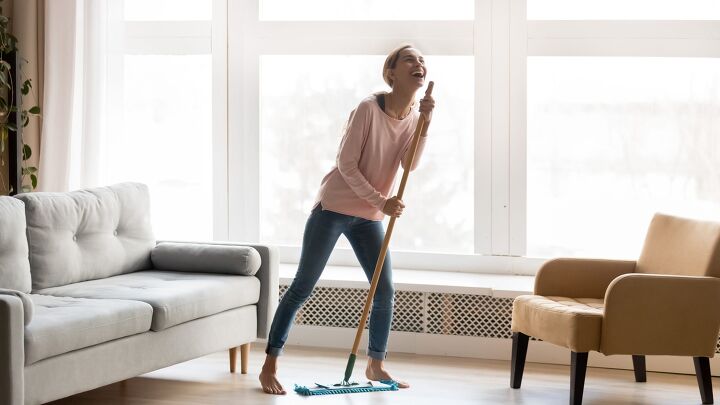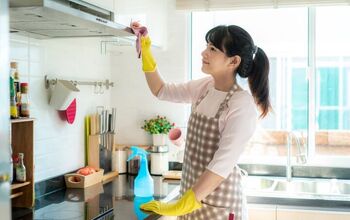Things You Should Never Clean With A Swiffer

Swiffers make it easy to clean your house without needing to drag a bucket around with you. The Swiffer’s cleaning solution is quite effective and eliminates the need to make a mixture of your own. However, Swiffers aren’t ideal for all applications. There are several things you should never clean with a Swiffer.
You should never clean a carpet, rug, or marble floor with a Swiffer. The Swiffer solution can damage marble because of its high alkalinity and it can soak through a carpet to the floor beneath it. Swiffers also aren’t ideal for laminate and vinyl floors because the solution can leave streaks and stains and in some cases, can even cause damage.
Luckily, you can clean many things with a Swiffer, and that includes your walls and ceiling. Follow along as we highlight the things you should never clean with a Swiffer.
What Should You Not Clean With Swiffer?
You shouldn’t clean materials like vinyl and laminate, among others, with a Swiffer. We all know that Swiffer sweepers make it easy to clean, but they aren’t ideal in every scenario. Swiffers rely on a highly alkaline cleaning solution to clean floors.
While this solution is quite effective, it can be harmful to several types of flooring materials. Let’s take a look at the top things you should never clean with a Swiffer.
Carpet
You should never clean your carpet with a Swiffer. Not only is it ineffective, but it can also damage your carpet and the floor beneath it. The cleaning solution can soak through your carpet and into the subfloor in extreme cases.
Use a vacuum instead so that you can remove dust and debris from the carpet fibers without getting them wet. Vacuuming and steam cleaning are the best options for rugs and carpets. If you insist on using your Swiffer to clean the carpet, make sure to use a dry pad and don’t spray the carpet.
Marble
You can damage your marble floors if you clean them with a Swiffer. The Swiffer cleaning solution is alkaline and can compromise the integrity of your marble floors. This can weaken the surface and even discolor it over time.
However, you could use a Swiffer with a fresh pad to clean your marble floors if you don’t use the Swiffer solution. Instead, soak the Swiffer pad in a solution of mild dish soap and warm water and scrub your floor. Simply pour ½ cup of mild dish soap into a bucket of warm water. This solution isn’t too alkaline for marble, and it’s enough to remove light stains.
Vinyl
While you can sweep vinyl floors with a Swiffer, it isn’t the best option. Unfortunately, vinyl floors are likely to get dirty quickly, and they require routine maintenance. Vinyl tends to hold onto dirt and grime, making it difficult to remove when you clean your floors.
Because of that, you will likely need to use multiple Swiffer pads just to clean your vinyl floors. Not only does this waste your money, but it’s also bad for the environment. The best way to clean vinyl floors is to mix white vinegar with warm water and mop the surface.
Laminate
It may be tempting to clean your laminate floors with a Swiffer, but it’s a bad idea. The alkalinity of the Swiffer’s cleaning solution can weaken the surface of your laminate floors. You are also likely to leave behind marks on the ground showing where you swept the floor, especially if you have shiny laminate flooring.
A solution of warm water, isopropyl alcohol, and mild dish soap is all that you need to clean laminate floors. Try to use high-percentage isopropyl alcohol (70%-99%) so that it will quickly evaporate after you scrub the floors.
Will Using A Swiffer Ruin Hardwood Floors?
Swiffers don’t typically ruin hardwood floors. However, you should exercise caution each time that you clean your hardwood floors with a Swiffer. For example, over saturating your floors with a cleaning solution can stain them or damage the finish.
The main downside to cleaning hardwood floors with a Swiffer is that you are unlikely to get all of the tough spots. It’s quite difficult to clean the corners in a room with a Swiffer because of the shape. Dirt, dust, and debris typically travel to the corners of rooms, especially if you have hardwood floors.
Never use a Swiffer on an unfinished or unsealed floor. Unfinished floors are much more sensitive to moisture and alkaline chemicals, so the solution could damage them. Try to use as little solution as possible when you clean hardwood floors with a Swiffer so that you don’t over saturate them.
Can I Use A Swiffer To Clean My Ceiling?
You can use a Swiffer to clean your ceiling, and it’s quite effective. However, you should be careful and make sure that you don’t use too much cleaning solution. This will ensure that fluid doesn’t drip from your ceiling down to the floor.
Many homeowners even use their Swiffers to clean the blades on their ceiling fans. You can also clean your walls with a Swiffer in many cases, but that’s not ideal if your walls are painted.
Is Swiffer Used For Sweeping Or Mopping?
Swiffers are used for both sweeping and mopping. You can use a Swiffer strictly as a broom if you simply don’t use the cleaning solution. However, the cleaning solution is part of the Swiffer’s biggest appeal because it reduces the workload of mopping your floors.
The ability to spray the cleaning solution onto your floors with the push of a button is what makes Swiffers so appealing. With that said, it’s still nice to have a mop around the house because they are more effective for cleaning large spills than Swiffers.
Summing It Up
Never clean your carpet, rug, or marble floors with a Swiffer. Swiffers include a cleaning solution that has high alkalinity that can weaken and stain marble floors. This cleaning solution is also bad for the fibers in your carpet, and it would take a long time to dry.
Try not to clean vinyl and laminate floors with your Swiffer. Luckily, you can clean hardwood floors with a Swiffer as long as you are careful. Avoid using too much cleaning solution on hardwood floors, however, as it could stain them.
Related Guides

Nick Durante is a professional writer with a primary focus on home improvement. When he is not writing about home improvement or taking on projects around the house, he likes to read and create art. He is always looking towards the newest trends in home improvement.
More by Nick Durante












![The 10 Best Table Saws - [2022 Reviews & Buyer's Guide]](https://cdn-fastly.upgradedhome.com/media/2023/07/31/9070645/the-10-best-table-saws-2022-reviews-buyer-s-guide.jpg?size=350x220)














